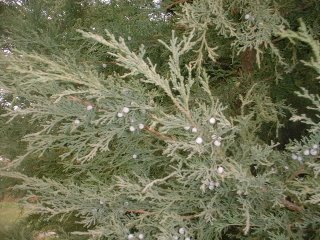
Eastern Red Cedar /Juniperus virginiana
A native evergreen that supplies food,nesting and winter shelter for birds and other wildlife.
I never really thought about it before but it seems the blue aromatic berries are actually cones
which only grow on the female.
Said cones are eaten by red squirrels, cedar waxwings, yellow rumped warblers and robins.
The Eastern Red Cedar is also host for the Olive hairstreak.
This is a large Eastern Red cedar growing way too close to our house. This year it has lots of the blue nice smelling berry/cones that make wonderful additions to a gathering of evergreen boughs for Christmas. I do not want to cut this tree down. It will take years to get a young replacement to form cones. Darn those foolish ones that did not know how large a Juniper virginiana may someday grow. Even just a few feet futher out and we could live with it. Now it has green only on the side facing away from the building. What to do...?
Read this mystery of the disappearing bark...
http://www.hiltonpond.org/ThisWeek041122.html


5 Comments:
Gloria, in central Texas we have the Eastern red cedar/ juniper, too, as well as a variety more common on the West of Austin, called the Ashe Juniper. They're a habitat for the endangered Golden-Cheeked warbler. When George W. is on the ranch in Crawford the photos frequently show him cutting down junipers, and describe it as 'cedar chopping', necessary because they'll take over the land, stealing all the water from trees like live oaks.
A dreadful allergy to the male, pollen-bearing members of this family, called cedar fever, is a reason people are glad to see them gone from residential areas. My own allergy to them is more than to the airborne pollen - just touching the foliage can bring on hives!
Since the females don't make pollen, I might leave a berried juniper in my yard for the birds, but it would have to be somewhere where I could avoid accidental contact, and of course could never use it in wreathmaking, no matter how attractive it looked.
I liked the link - thank you.
Annie at the Transplantable Rose
PS Gloria, did you intentionally set up your comments to exclude those without a Blogger account? People coming from other formats like Typepad won't be allowed to leave you messages unless you say an anonymous comment is allowed.
Annie, I did not notice anonymous was excluded. Thank you for mentioning.
Oh my, are you allergic to all junipers? Is the allergy very common?
This is an old neighborhood, most of the big evergreens are spruce but you find a lot of the Juniper fastigiate like 'Skyrocket' done in spirals or yews in box shape.
Don't know which evergreen is used in the puffs they are unidentifiable from a distance.
Last few years the arborvitae has been popular.
Rarely is there a pine here about.
One of the Austin garden bloggers had friends who wanted to comment but couldn't - that's how I knew about it.
This allergic reaction to any contact with junipers appeared in the late 1980's - I don't know if it's common. The 'cedar fever' from the pollen takes over the whole city of Austin in midwinter, and we have an amazing array of allergy doctors to go with it!
We have very few needled evergreens to choose from here, and none of them are my old favorite spruces,. Instead there are a lot of trees and shrubs with evergreen leaves, broadleaf evergreens like viburnums, hollies, boxwoods and magnolias, as well as native trees like live oaks, Cenizo and Mescal beans - so I should not complain, but I still miss the tall, pointed evergreens.
Annie at the Transplantable Rose
Interesting information. More people should include plants like these in the landscape so the birds have a places to roost.
Carol,that is why I am a habitat gardener. To help provide a sort of rest area for natures travelers through the urban areas.
Post a Comment
<< Home